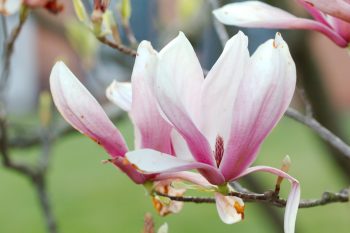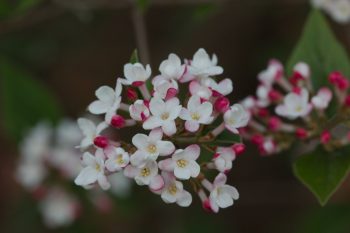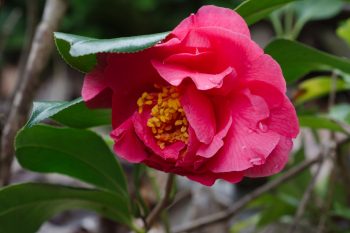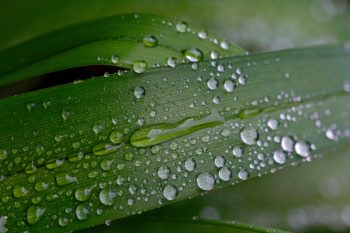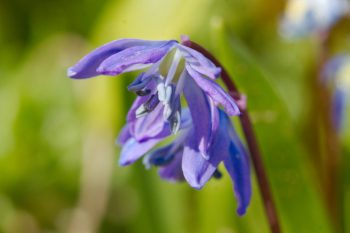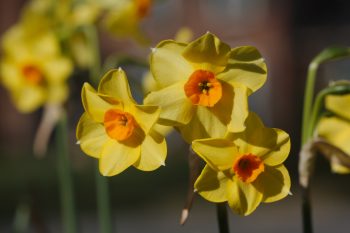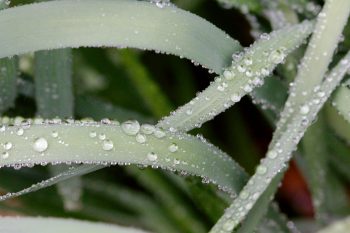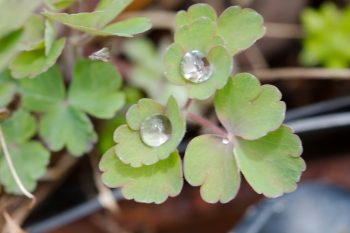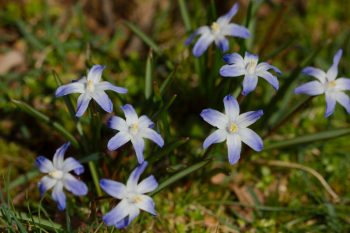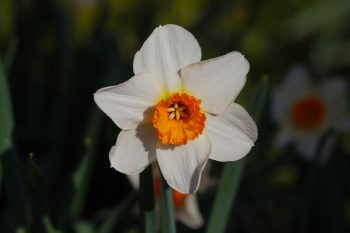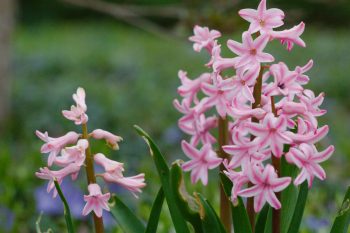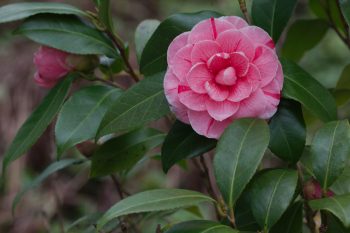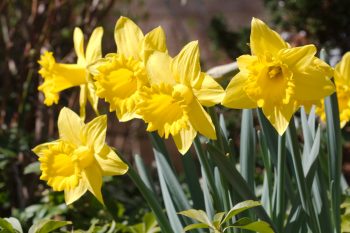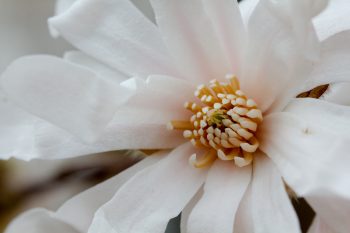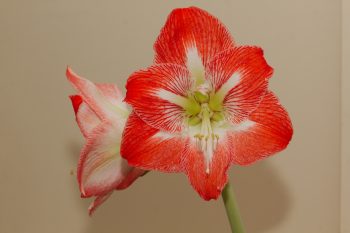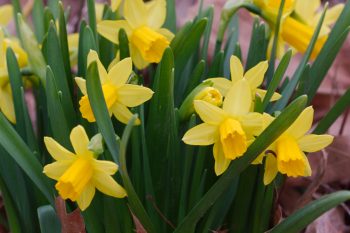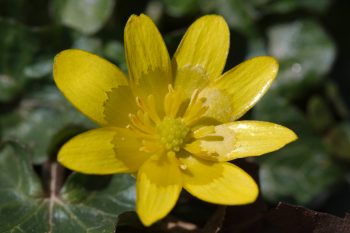Most of the saucer magnolias (Magnolia × soulangeana) have finished their bloom but there are a few in the neighborhood that are still at their peak. This has been a good year for the magnolias, coming a little early and with no late frost to damage them. The saucer magnolia is a hybrid of M. denudata x M. liliiflora. The first of those, the yulan magnolia, has pure while flowers, which seems like it would be very nice, as well. The second, commonly called the lily magnolia, is a bit more hardy and provides the hybrid with its color. Many of the named varieties of saucer magnolia come from a breeding program at the U. S. National Arboretum. The hybrid epithet comes from Chevalier Etienne Soulange-Bodin (1774–1846), a “disgruntled cavalry officer.”
Flowers and Plants
Magnolia × soulangeana
Viburnum carlesii
One thing Cathy and I are thankful for is walks in our neighborhood. It’s a relatively quiet neighborhood, especially now, as traffic in the area is considerably lighter than normal. Foot traffic has always been high with a lot of dog walkers and people out for a stroll but that’s increased significantly during the covidian interval. This shrub, Viburnum carlesii, is scattered through the area and right now, you can often smell it before you see it. The fragrance it strong, spicy, and sweet with a hint to me of vanilla. This and Viburnum × burkwoodii, which is cross with V. utile, are among the best viburnums for fragrance (and it’s possible that the one in this photo is the hybrid rather than the species). In fact, Cathy has requested that I plant one in our yard when we’re able to browse the garden centers once more.
Camellia
There is a pink flowering dogwood (Cornus florida) growing up against the front of our house. I’m almost certain it’s a seedling, because it’s much too close to the house to have been planted and I want to take it out. Before I do, I’d like something growing that will take its place but I may just need to do the deed. A few years ago I planted a camellia called ‘Mrs. Lyman Clarke’ but the two very cold spells we had in the next two winters did that one in. In 2017 I bought a variety called ‘Kumasaka’, which is fairly hardy, as camellias go. It nearly died the first year but there is a small stem with about 8 leaves on it and this spring it bloomed. I’m not entirely sure this is ‘Kumasaka’ and not the root stock, but it’s a big, beautiful, pink flower so I’ll live with it. Hopefully it will live with us. And hopefully it will start to put on a little growth because right now, it’s barely taller than the pachysandra.
Water Droplets
We had another rainy day today, to end March. It’s been so warm and sunny lately that it was a bit of a shock to stay indoors all day. I did get outside long enough to take a handful of pictures, but really not much more than that. These are daylily (Hemerocallis) leaves with rain on them, and the rain continued to fall while I was taking it. I probably should have spent the time to get a tripod and really focus carefully, but I just needed to get a picture. Maybe next time. Sorry.
Daffodil ‘Actaea’
This is a daffodil called ‘Actaea’, which is in the poeticus division (division 9), which are distinguished by their large white petals and small, dainty cups in contrasting colors. I think they are fairly posh, compared to their more boisterous cousins but they are similar in their hardiness. They are a bit slower to produce large clumps, though, so if you want a lot of them in a hurry, you’ll want to plant more of them up front. The stems on these are a little less rigid than the others, as well, and they have a tendency to droop even more when it rains but in the sun, they are hard to beat.
Scilla siberica
Blooming shortly after the beautiful, blue Chionodoxa forbesii (glory of the snow), the Scilla siberica (Siberian squill) are starting to come out. They are a darker blue with down-turned flowers but quite similar. In fact, “some experts have merged Chionodoxa into the genus Scilla under the belief that the differences are not significant enough to warrant separate genus status.” (Missouri Botanical Garden, Plant Finder). I don’t really care one way or the other and just enjoy them both as spring ephemerals. I look forward to their bloom every year and don’t think I could have too many of either.
Daffodil ‘Falconet’
One nice thing about being home as we all are is that it means I can get out into the yard during the day. That’s offset by the fact that we can’t go a lot of other places, of course, but we are fortunate to have a pretty nice yard. There’s a huge amount that needs to be done but right now, with the daffodils blooming, it’s quite nice. This little daffodil, one of the Tazetta types, has multiple fragrant flowers on each stem. They were planted in 2014 and are on the edge of the bed that used to surround the spruce tree, which is gone, so they will get a lot more sun now.
Daffodil Leaves In The Rain
It rained again today and I spent most of the day indoors, working. We’re into our second week of the great coronavirus hunker of 2020 and it’s been a mixed bag. On the one hand, when the weather has been nice, which has been most days, it’s been great to get out into the yard. That’s nicer than just going out into the parking lot at work. But when it’s cool and dreary, and I’ve stayed indoors, it’s gotten a bit old, sitting at my computer. It’s nice to be able to do that in an armchair with the computer on my lap, but it’s still work and I much prefer to be able to go outside.
Columbine Leaves
It’s been really nice weather lately, which is great. Since we’re staying around the house, it’s been good to get outdoors, even if only into the yard. We say hello to all the neighborhood walkers, of which there are quite a lot. Today was a bit dreary by comparison so we spent most of the day indoors. I did get out a bit and took a few pictures of things in front of the house, including this columbine leaf with two large water droplets.
Chionodoxa forbesii
I think this is my absolute favorite of the spring ephemerals. It’s called glory of the snow in honor of it’s generally very early blooming time, sometimes when there is still snow on the ground. The genus Chionodoxa comes from the Greek words chion meaning snow and doxa meaning glory. I think it’s the color that I like best about it, along with its dainty habit and it’s remarkably easy care. It is hardy as far north as USDA zone 3. In a few short weeks it will be done and gone for the year, sleeping away both the heat of summer and the cold of next winter.
Wild Violet
The wild violets (Viola sororia) are up in the lawn. They’re pretty difficult to get rid of but our lawn is not particularly weed free in general, so they are among the least of our worries. The flowers range in color from nearly all white to nearly all bluish purple. This one is about half way in between. We actually have a few yellow violets and I’m assuming those are a different species, possibly Viola pubescens, but I don’t actually know that. They look very similar to these, except for the flower color.
Box Flowers
There were a few mid-sized box shrubs along our front walk when we bought the house in 2006. Between a few heavy snowfalls breaking some of their stems and a particularly dry summer one year, they have died back to one main stem. It’s doing fine although it looks a little sad, with the rest of the bush gone. There is another, much larger box at the corner of the garage and it made it through the same years with little or no apparent damage. They are in bloom right now, although as you can see, no one is likely to grow box for their flowers.
Daffodil
This is one of my unknown daffodils. The fall when we moved into our house I took some family pictures for some friends and they gave me a bunch of bulbs as a thank you present. They either were not marked or, more likely, I didn’t write down the names, but they bloom every year. This is one of them. There is another, very double daffodil as well and the hyacinths that I posted a picture of a couple days ago. The daffodils are between our front walk and the house and put on a really good show.
Pink Hyacinths
The hyacinths are in bloom. These were planted pretty soon after we moved in and they didn’t really thrive but every year they come up. There are three little clumps of them, one purple, one white, and this pink one. They are growing in a bed of Vinca minor, also known as periwinkle, and lily of the valley (Convallaria majalis). You can see a little of the periwinkle color in the background. It’s nice to see them out our kitchen door. I’m not a fan of their fragrance, so I like they more at a distance than close up.
Camellia ‘Dad’s Pink’
I currently have three camellia plants in the yard. This one it the largest and has the most flowers. It’s called ‘Dad’s Pink’ and though it isn’t a variety that my dad grew, it reminds me of him. I also have ‘Pink Perfection’, which he did have. That one ws quite small when I got it and has taken a little while to get established but it looks like it’s doing pretty well finally (and after I lowered the pH around it a bit). The third is called ‘Mrs. Lyman Clarke’ and dad had that one, as well, out back beside the chimney. It’s barely alive and only time will tell if it’s going to survive. It has six leaves and one flower bud.
Daffodil ‘Arkle’
As mentioned yesterday, the daffodils are really starting to come out in great numbers. This is one called ‘Arkle’ and it’s a big, bold, beautiful yellow flowered variety. I planted these back in 2014 and they are very well established. Daffodils are long lived and form nice clumps. Where you put one bulb, you will eventually have a group of them, each putting up flowers, so the longer they are in the ground, the better. Others that were planted more recently, a variety called ‘Marieke’ that has similar but slightly larger flowers is still putting up only 3 or 4 blooms per clump. But they should continue to get better each year.
Star Magnolia
The star magnolia (Magnolia stellata) is a really nice flowering tree, relatively slow growing but eventually getting up to about 20 feet tall and nearly as wide. It flowers rather early in the spring and it’s not uncommon, at least here, for the blooms to be killed by a late frost. We’ve been spared that this year and they are blooming all over right now. The generally later saucer magnolia (Magnolia × soulangeana) is starting to bloom around the neighborhood, also. There are some cherries blooming and the daffodils are coming out in great numbers. It’s a pretty time of year.
Amaryllis
We have two amaryllis bulbs from last year that we pretty much neglected after they finished blooming. They had leaves for a while but we stopped watering them and they just sat on shelves in the kitchen after that. They normally bloom around Christmas time, which is lovely, of course, but we weren’t paying them any attention. A week ago I notice this one had sent up a shoot with a bud on top so it got a little water. It has rewarded our neglect with two lovely blooms. It now has a spot on the kitchen counter. I had to add two stakes to hold it up because the flowers are pretty heavy and the pot it’s in is not.
‘Tete-A-Tete’ Daffodils
Daffodils are starting to bloom all over. The early varieties, particularly in warm locations, have been in bloom for a week or so. These are our first to get fully out. They are called ‘Tete-A-Tete’ and they are a nice, little, clump-forming variety that I really like. We have them in a few places and they are very happy, blooming as the others are still forming buds. They are only about 8 to 10 inches tall, so not suited for growing in with too much ground cover. So, in the pachysandra we have taller varieties, like ‘Arkle’ which is big and bold but blooms a little later.
Ficaria verna
This is Ficaria verna, formerly known as Ranunculus ficaria, commonly called the fig buttercup or lesser celandine. It is a weed and is listed as a noxious weed by a bunch of states and banned in at least two. It’s growing wild in the area around the pond next to my building. I’ve had enough experience with invasive weeds that I understand the desire to keep them out so I wouldn’t ever plant this. Nevertheless, I can appreciate the beautiful, bright yellow flowers. It is a tuberous rooted, herbaceous perennial native to western and central Asia and Europe. After flowering, the leaves die back by early summer and the plant goes dormant until the next spring.

